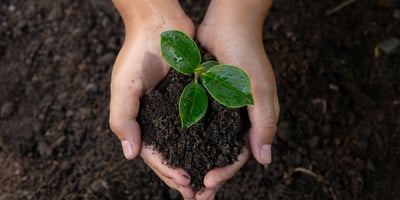Farming is essential work, led across the country by people facing new challenges. From economic...
Ag Issues: The Farm Economy
Farming is essential work, led across the country by people facing new challenges. From economic viability and labor shortages to technological advances and succession planning, today’s agricultural professionals are thinking about more than their grandparents were.
This new series dives into the top issues facing farmers in the next 10 years. Something on your mind? Fill out our contact form to let us know what you’d like to hear about.
.png?width=900&height=506&name=Farm%20finances%20(1).png)
The farm economy isn’t in peak shape right now. Prices are low, costs are high, and shifting trade agreements have been in the headlines. The current recession is even making ag producers ask whether we’re in a farm crisis similar to the 1980s.
While we have some ideas about how boom and bust cycles are triggered, predicting the timing of these cycles remains a challenge for economists. But there are some clues, and experts have tips for farmers on how to stay economically viable until we return to a more profitable period.
How did we get here?
The farm economy last peaked in 2022 with record net farm income, and before that in 2012. Chad Hart, Professor and Extension Economist at Iowa State University, says that the recent downturn looks a lot like the downturn after the 2012 peak, but with a much sharper drop.
For the last few years, demand for grains and animal products have been on the rise. Crop farmers have risen to the challenge, and with ideal conditions and growing strategies have been able to over-produce that high demand.
While feeding America’s families is a strong positive, this also brings about the first challenge: high supplies led to lower prices for farmers selling crops. With much of the U.S. currently harvesting, supplies are also seasonally at their largest.
At the same time, inflation has exploded, increasing prices on everything from seeds to new equipment. What cost farmers $1,000 in August 2012 would now cost them an extra $400, according to the U.S. Bureau of Labor Statistics CPI Inflation Calculator, with more than two thirds of that increase coming since August 2020.
Today’s higher interest rates, tariffs, and logistical supply chain issues are also now exacerbating these issues.
“Take fertilizer for example,” Hart said. “We need fertilizer to grow our crops, and we import a lot of fertilizers. Anything that disrupts that flow raises the cost of fertilizer, which raises the cost of producing corn, soybeans, and wheat. We’re facing logistical challenges for getting those supplies into the country, and at the same time fertilizer prices are being inflated by tariffs placed on the products by both the U.S. and other countries globally.
“These things layering on top of each other are creating financial hurdles that farmers are having a harder and harder time clearing, given that they were already struggling before these issues started,” he said.
In light of the present situation, farmers are left with two questions on how to fix the squeeze they’re feeling. How can I lower costs to match prices? And when will we get higher prices to match these higher costs?
What can I do to protect my farm?
Fall is the time to look at your budgets and prepare for the coming year’s production. Compare all of your income sources to your estimated expenditures, including a buffer for unexpected expenses like bad weather. And while it may not be fun, shop around for better deals to control costs rather than cut.
“Right now we need every penny we can conserve, so we have to put pencil to paper to see if we’re really getting return on investment from buying this fertilizer versus another cheaper one,” Hart said. “Farmers hate to step away from good business relationships, but at this point in the economic cycle it would behoove us to do so to find the best deal.”
To enhance revenue, Hart says farmers should make moves when they have to and look outside the farm for secondary streams of income. Look for crop storage, consider marketing techniques, think outside the box. Winter brings on a demand for snow plowing, and farmers have equipment capable of moving that snow.
“We have to take advantage of what these markets offer us,” Hart said. “Make sure to capture prices that cover your costs, and if you’re getting a profit, use some of it to invest in the farm and in the community. Those things can prime the pump for the general economy in the region and may even bring us back out of a recession. Things have to land right not only on the farm, but also in the market.”
Hart also recommends farmers keep an ear out for chatter about federal financial support for farmers in light of the present trade situation. While it won’t be a long-term cure, it could alleviate some of the cashflow symptoms of this recession.
When will this be over?
Generally, the farm economy goes through 10-year peak-to-peak cycles that fluctuate in length and don’t always line up with the economy at large. However, experts can’t predict exactly when the economy will improve, in the same way they can’t determine what will fix the problem.
Despite this, Hart says there are encouraging signs for worried farmers. For one, in spite of rising grocery bills, consumers are still paying record prices for beef in stores, a major support for the cattle industry.
“Even though we’re in this recession, when I look at the demand structure for corn, soybeans, cattle or hogs, I see really good consumer demand,” he said. “It’s mostly a matter of allowing that demand to catch up to where we are right now, and it will.”
“Ag goes through cycles like this, we’re going through another cycle, we’ll reappear back out the other side,” Hart said.
Want to learn more?
The Center for Rural Affairs provides farm finance resources for new farmers and farmers planning a farm transition. State Extension Offices also often have resources available to farmers looking for advice, including Iowa State, the University of Missouri, the University of Wisconsin-Madison and more.
Agricultural marketing services including Trader PhD can also help farmers watch the markets and provide actionable insights into price trends and historical data. We work alongside farmers to help navigate the markets in a way that best fits their operation. While farmers know their operations best, it’s always nice to have an expert in your pocket distilling what’s most important.
- - -
Hi! We’re Trader PhD, an Ag Marketing service located in West Des Moines, Iowa. We give commodity market advice to grain and livestock producers across the U.S. and Canada.
With over 30 years of experience serving farmers and ranchers, our team specializes in strategic hedging and speculating in the livestock and grain markets. We offer essential tools and market insights that help agricultural professionals make informed decisions, safeguard profitability, and manage commodity marketing efficiently.
Articles about current market trends are published on our app daily. Sign up for your free trial today for full access to Trader PhD’s editorial catalogue.
PAST PERFORMANCE IS NOT INDICATIVE OF FUTURE RESULTS. FUTURES TRADING INVOLVES SUBSTANTIAL RISK AND IS NOT SUITABLE FOR ALL INVESTORS.
.png?width=2347&height=620&name=outlined%20ag%20marketing%20logo%20black%20(1).png)



